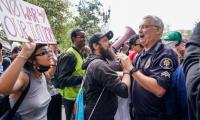The world we live in is a world built primarily through a male lens. This can be seen in film and on television, in politics and academia. The reasons for this are many, but boil down to one essential fact: the existence of patriarchy.
It’s true that in recent times, various aspects of male domination of the public sphere have been modified in reaction to the demands of women and the necessities of the marketplace. However, the patriarchal structure is still quite intact. Like white supremacy, it continues to distort and diminish the possibilities of the human experience.
Beyond the obvious masculine perspectives of the phenomena mentioned above are those unnoticed elements of our existence that accentuate the male gaze. Perhaps the least noticed of these is the masculine framework of urban life. It is at its most obvious when a cluster of sexual assaults on women take place in an urban area or the police are engaged in pursuing a serial rapist.
Women and girls are warned not to travel alone, not to travel at night, and preferably to stay at home. They are further encouraged not to dress provocatively or drink alcohol. Right now, you might be thinking that these warnings are not sexist in any way but are just common sense. In other words, women and girls are told they must live in fear. Indeed, this is the case even when there is not a highly publicized sexual assault case. However, what these situations ignore is the social function of fear that geographer Leslie Kern describes in her book Feminist City: Claiming Space in a Man-Made World.
Kern’s text follows in the tradition of urbanist Mike Davis and his discussions of how architecture enhances control of marginalized city dwellers and British Israeli architect Eyal Weizman’s discussions of Israeli architecture and its purpose in controlling Palestinians. She looks beyond the three dimensional elements of urban construction and delves into the reasons cities are built the way they are. Although she touches briefly on the economics of capitalism in urban areas – with a special focus on gentrification – her incorporation of the role women play in gentrification is what makes her analysis interestingly unique.
Given her life as an academic with a middle-class lifestyle and white skin, her perspective is representative of her class and position. At the same time, her political understanding that her desires and hopes are not necessarily the same as those of women of color, immigrant women, lesbians and trans women, sex workers and working-class women entails that she remind the reader of this. Indeed, when writing about gentrification, Kern discusses how highly secure condo buildings in formerly “rough” neighborhoods are advertised with women like her in mind. Given that these are often the first indicators of a neighborhood beginning gentrification, she notes that white women become the equivalent of settlers encroaching on native lands.
Tangentially, she discusses how the tendency among some women to demand more police in these and other urban neighborhoods ignores the brutal reality of police harassment and surveillance of Black, immigrant and poor districts.
This is a small but provocative book. It is both an introduction to feminist geography and to modern feminism, with its multiple meanings and numerous contradictions. Kern does not provide many answers but raises many questions. In a world where the male gaze is so often the only gaze considered; so much so most people don’t even think of it as being gendered in any way, Feminist City is revelatory. It is a look at urban worlds (especially those of the west) through the eyes of a woman. In other words, the female gaze.
If we accept Kern’s text as a discussion of the modern neoliberal capitalist city through a feminist/women’s lens, the selections in Black Rose’s Social Ecology and the Right to the City is an expansion of that discussion. The context here is the political philosophy known as social ecology – an anarchism informed by Marxist thought and developed by Murray Bookchin and like-minded thinkers and activists. The other thinker referred to in some of the other essays is the French philosopher Henri Lefebvre, whose tract The Right to the City expanded the Marxian revolutionary class beyond workplace walls out to those who live in and democratize the city in defiance of the industrialists and financiers determined to make the metropolis just another point of profit for them.
Where Kern wonders how to create the feminist city as a humane space managed and designed by all those who live there, especially those who aren’t wealthy and primarily interested in property as investment, this text presents efforts by city dwellers to establish such a space. In other words, it is necessary for the discussion about a future democratic, feminist city into the streets. Kern understands this, but seems unsure how to make it so. Most of the writers in this book either are already acting towards this goal or have some grassroots ideas how we might bring it about.
Amongst the essays discussing the nature of the metropolis in late stage capitalism and the need to wrest urban spaces back from the profiteers and financial predators are pieces describing recent and ongoing actions attempting exactly that. One article describes the politics and the practice involved in liberating and maintaining privatized space in Greek cities. These spaces are now public gardens and encampments; protest spaces and shelters. Another piece looks at squatting in Brazil and Spain. Still others refer to the attempts led by Kurds in Rojava to create the municipalities envisioned by those who call themselves social ecologists.
Excerpted from: 'Is a Feminist City Potentially a Humane City?'
Courtesy: Counterpunch.org
A representational image showing residents walking at a wholesale market in Karachi. — AFP/FileOnce again there is...
A representational image showing late Pakistani human rights activist and Supreme Court lawyer Asma Jahangir. —...
A representational image showing a security personnel sanding guard beside a ship carrying containers at Gwadar port....
A health worker administers polio vaccine drops to a child during a door-to-door polio vaccination campaign in Lahore,...
Armed militants of the banned Tehreek-e-Taliban Pakistan pose for a photograph in Orakzai Agency. —...
An aeroplane of the national flag carrier of Pakistan is seen in this file photo. — AFPWhile Pakistan considers...







